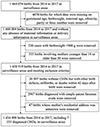Maternal Exposure to PM2.5 and the Risk of Congenital Heart Defects in 1.4 Million Births: A Nationwide Surveillance-Based Study
- PMID: 36780386
- PMCID: PMC9988362
- DOI: 10.1161/CIRCULATIONAHA.122.061245
Maternal Exposure to PM2.5 and the Risk of Congenital Heart Defects in 1.4 Million Births: A Nationwide Surveillance-Based Study
Abstract
Background: Evidence remains limited about the association of maternal exposure to ambient fine particulate matter (airborne particles with an aerodynamic diameter ≤2.5 µm [PM2.5]) with fetal congenital heart defects (CHDs) in highly polluted regions, and few studies have focused on preconception exposure.
Methods: Using a nationwide surveillance-based case-control design in China, we examined the association between maternal exposure to PM2.5 during periconception (defined as 3 months before conception until 3 months into pregnancy) and risk of CHD in offspring. The study included 1 434 998 births involving 7335 CHDs from 2014 through 2017 on the basis of the National Population-Based Birth Defects Surveillance System, covering 30 provinces, municipalities, or municipal districts in China. We assigned maternal PM2.5 exposure during the periconception period to each participant using satellite-based PM2.5 concentrations at 1-km spatial resolution. Multilevel logistic regression models were used to calculate the multivariable-adjusted odds ratio and 95% CI for CHDs in offspring associated with maternal PM2.5 exposure, and the exposure-response association was investigated using restricted cubic spline analysis. Subgroup or sensitivity analyses were conducted to identify factors that may modify the association.
Results: The average maternal exposure to PM2.5 levels across all participants was 56.51 μg/m3 (range, 10.95 to 182.13 μg/m3). For each 10 μg/m³ increase in maternal PM2.5 exposure, the risk of CHDs in offspring was increased by 2% (odds ratio, 1.02 [95% CI, 1.00 to 1.05]), and septal defect was the most influenced subtype (odds ratio, 1.04 [95% CI, 1.01 to 1.08]). The effect of PM2.5 on CHD risk was more pronounced during the preconception period. Mothers <35 years of age, those living in northern China, and those living in low-income areas were more susceptible to PM2.5 exposure than their counterparts (all P<0.05). PM2.5 exposure showed a linear association with total CHDs or specific CHD types.
Conclusions: High maternal PM2.5 exposure, especially during the preconception period, increases risk of certain types of CHD in offspring. These findings are useful for CHD prevention and highlight the public health benefits of improving air quality in China and other highly polluted regions.
Keywords: congenital; environment; heart defects; pregnancy.
Conflict of interest statement
Disclosures
None.
Figures



References
-
- Botto LD, Correa A. Decreasing the burden of congenital heart anomalies: an epidemiologic evaluation of risk factors and survival. Progr Pediatr Cardiol. 2003;18:111–121. doi: 10.1016/s1058-9813(03)00084-5. - DOI
Publication types
MeSH terms
Substances
Grants and funding
LinkOut - more resources
Full Text Sources
Medical

